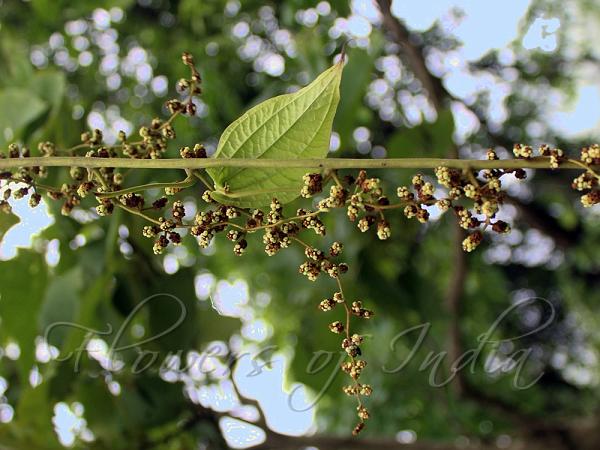|
| Intoxicating Yam |
|

|

| File size | 215574 |
| Original date | 7/29/17 11:14 AM |
| Resolution | 1000 x 750 |
| Flash | Flash did not fire, auto |
| Focal length | 23.0mm |
| Exposure time | 1/200s |
| Aperture | 3.5 |
| Focus Distance | |
| Metering Mode | Spot |
| Camera make | Canon |
| Camera model | Canon EOS 700D |
| Sensor type |
|
|
|
|
Photo: |
Botanical name: Dioscorea hispida Family: Dioscoreaceae (Yam family)
Synonyms: Dioscorea hirsuta, Dioscorea daemona, Dioscorea lunata
Synonyms: Dioscorea hirsuta, Dioscorea daemona, Dioscorea lunata
Intoxicating Yam is a twining vine, arising from
tuberous roots, and reaching a length of several meters. Flowers are
borne in panicles up to 45 cm long, in leaf-axils. Racemes are
fascicled, shortly stalked, up to 1 cm long. Male flowers arise in
dense clusters; perianth about 1 mm, outer lobes smaller and thinner
than inner ones; stamens 6. Female spike solitary, up to 40 cm. Stems
are twining to the left, hairless. Leaves are alternate, 3-foliolate,
leaf-stalk up to 12-30 cm. Leaflets are nearly equal, ip to 17 x 12 cm,
obovate, abruptly sharply tapering at tip, wedge-shaped to the base,
shortly stalked, ribs 5, prominent intercostae coarsely netveined,
thinly bristly; lateral leaflets gibbous at base.Capsule long
ellipsoid, 3.5--7 cm, leathery, densely velvet-hairy; wings 1.2--1.5 cm
wide. Juice of underground stems reported to possess narcotic
properties. In Kerala, India, tuberous herb cooked with salt, chili,
tamarind and tumeric powder and used as curry.
Intoxicating Yam is found in the Himalayas, from Nepal to Sikkim, at
altitudes up to 1500 m, and also in the tropics of Asia from South
India to Taiwan, Philippines, New Guinea. Flowering: April-May.
Medicinal uses: In Bangladesh, tubers used to
kill worms in wounds. Various plant parts used in whitlow, sores,
boils, and bites of rabbit, jackal or dog. In India, tubers used for
birth control. In Malaysia, pounded leaves applied to sores of yaw.
In Bangladesh, tubers used to
kill worms in wounds. Various plant parts used in whitlow, sores,
boils, and bites of rabbit, jackal or dog. In India, tubers used for
birth control. In Malaysia, pounded leaves applied to sores of yaw.
Medicinal uses:
 In Bangladesh, tubers used to
kill worms in wounds. Various plant parts used in whitlow, sores,
boils, and bites of rabbit, jackal or dog. In India, tubers used for
birth control. In Malaysia, pounded leaves applied to sores of yaw.
In Bangladesh, tubers used to
kill worms in wounds. Various plant parts used in whitlow, sores,
boils, and bites of rabbit, jackal or dog. In India, tubers used for
birth control. In Malaysia, pounded leaves applied to sores of yaw.
| Identification credit: Shrikant Ingalhalikar, Prashant Awale | Photographed near Mumbai, Maharashtra. |
• Is this flower misidentified? If yes,